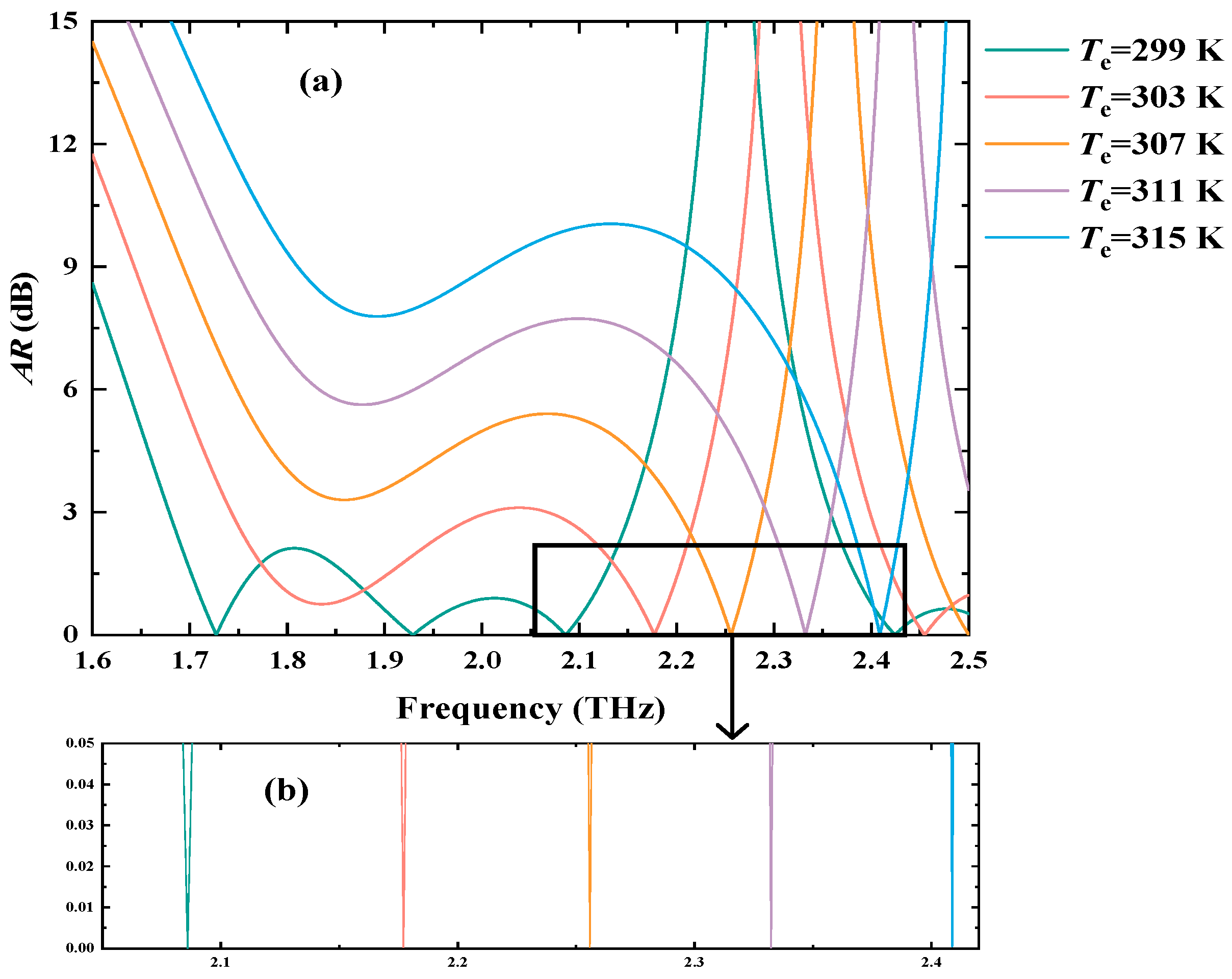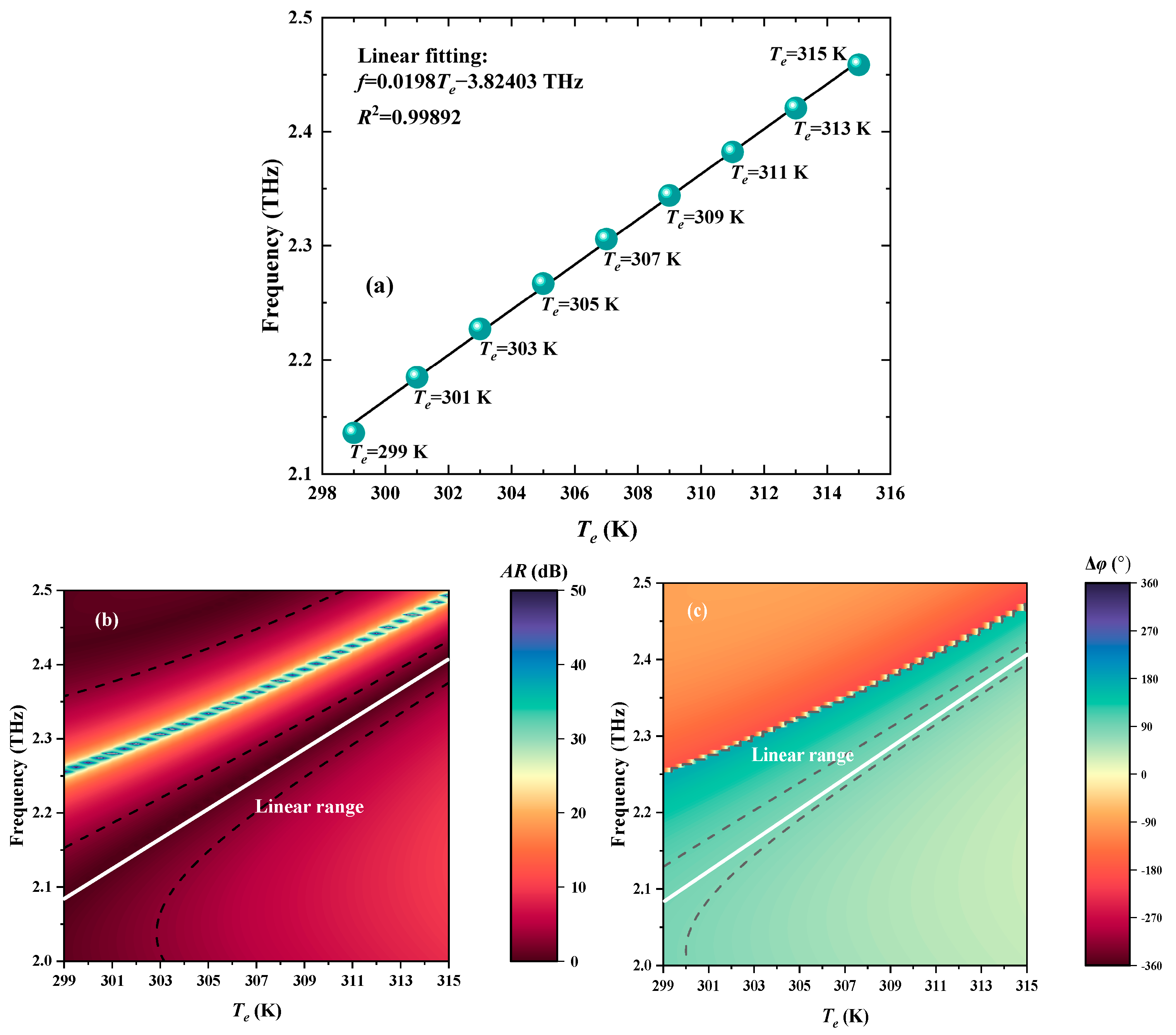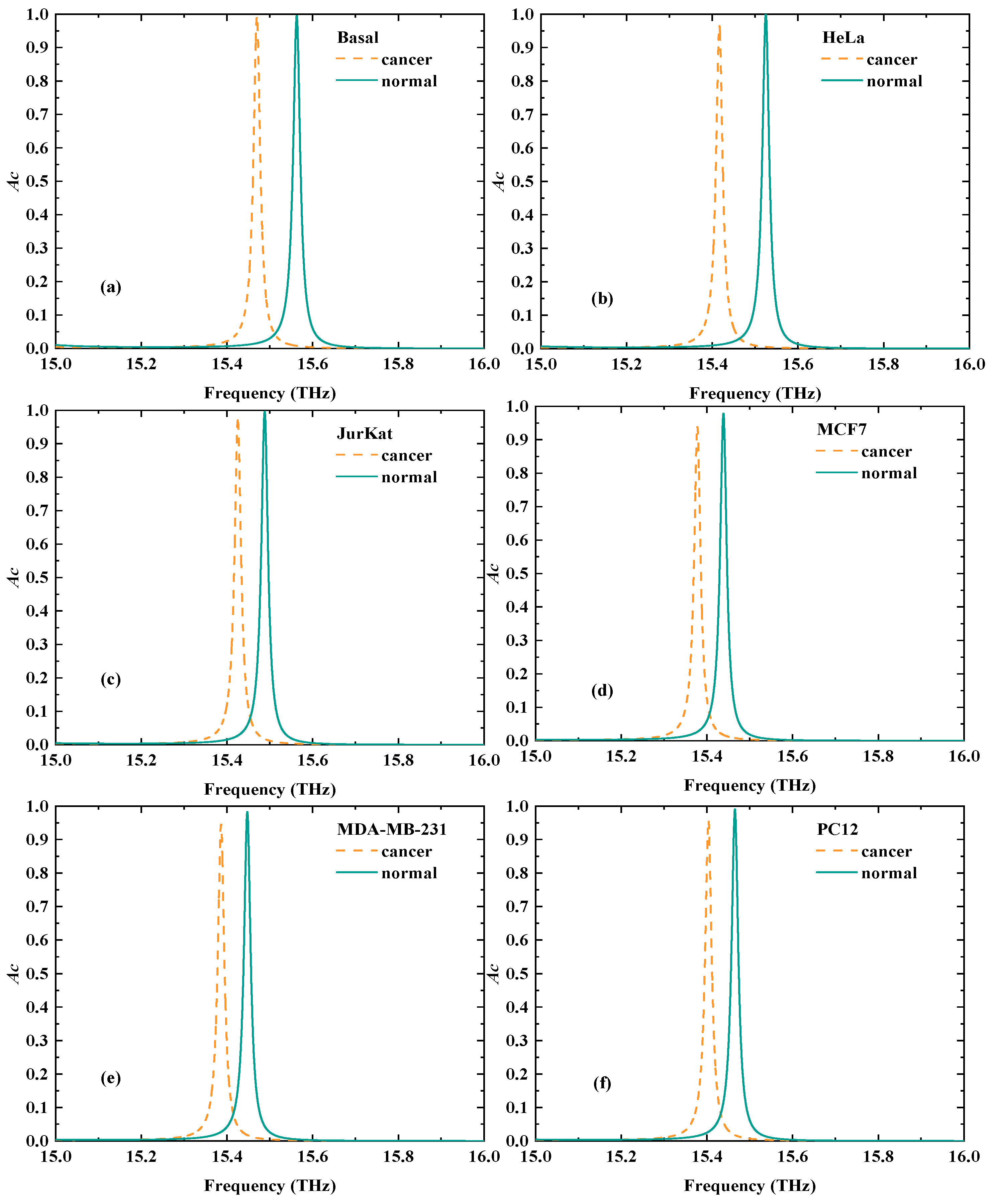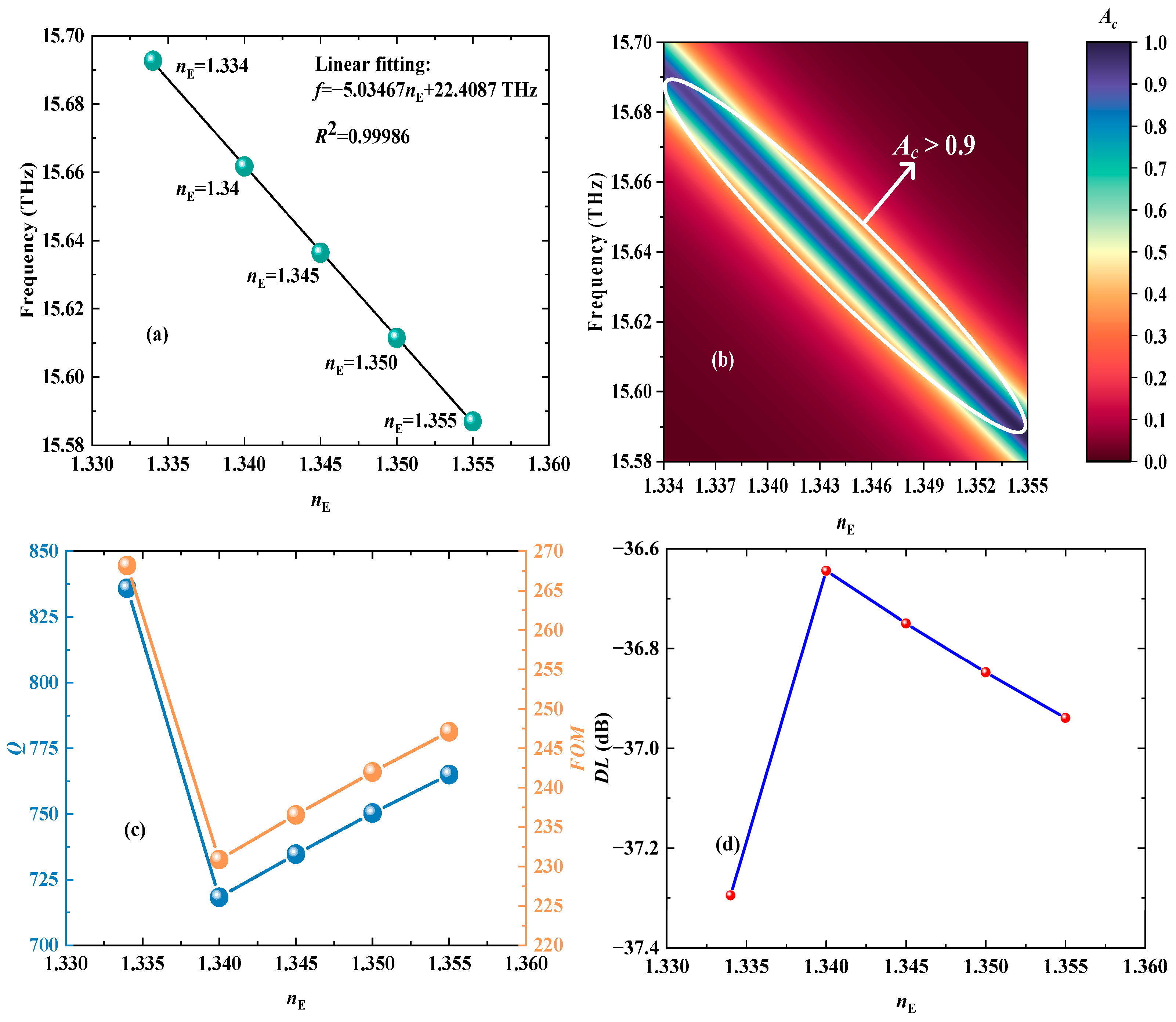Theory Design of a Virtual Polarizer with Multiscale and Multi-Biomass Sensing
Abstract
1. Introduction
2. Materials and Methods
3. Results and Discussion
4. Conclusions
Supplementary Materials
Author Contributions
Funding
Institutional Review Board Statement
Informed Consent Statement
Data Availability Statement
Conflicts of Interest
References
- Baranov, D.G.; Krasnok, A.; Shegai, T.; Alù, A.; Chong, Y. Coherent perfect absorbers: Linear control of light with light. Nat. Rev. Mater. 2017, 2, 1–14. [Google Scholar] [CrossRef]
- Gupta, S.K.; Zou, Y.; Zhu, X.Y.; Lu, M.H.; Zhang, L.J.; Liu, X.P.; Chen, Y.F. Parity-time symmetry in non-Hermitian complex optical media. Adv. Mater. 2020, 32, 1903639. [Google Scholar] [CrossRef]
- Wan, W.; Chong, Y.; Ge, L.; Noh, H.; Stone, A.D.; Cao, H. Time-reversed lasing and interferometric control of absorption. Science 2011, 331, 889–892. [Google Scholar] [CrossRef] [PubMed]
- Chong, Y.D.; Ge, L.; Cao, H.; Stone, A.D. Coherent perfect absorbers: Time-reversed lasers. Phys. Rev. Lett. 2010, 105, 053901. [Google Scholar] [CrossRef] [PubMed]
- Krasnok, A.; Baranov, D.; Li, H.; Miri, M.A.; Monticone, F.; Alú, A. Anomalies in light scattering. Adv. Opt. Photonics 2019, 11, 892–951. [Google Scholar] [CrossRef]
- Wu, C.Q.; Wu, Y.R.; Zhang, H.F. The detection of seawater elements by virtual polarizer capable of coherent perfect ultra-wideband polarization control. Measurement 2025, 248, 116983. [Google Scholar] [CrossRef]
- Wu, Y.R.; Dong, R.Y.; Zhang, H.F. Virtual Polarizer: Coherent Perfect Ultra-wideband Polarization Control Of Chiral Electromagnetic Waves. IEEE Trans. Antennas Propag. 2024, 72, 4370–4382. [Google Scholar] [CrossRef]
- Song, Q.; Merajver, S.D.; Li, J.Z. Cancer classification in the genomic era: Five contemporary problems. Hum. Genom. 2015, 9, 27. [Google Scholar] [CrossRef]
- Yu, Z.; Li, M.; Xing, Z.; Gao, H.; Liu, Z.; Pu, S.; Zhang, C. Genetic algorithm assisted meta-atom design for high-performance metasurface optics. Opto-Electron. Sci. 2024, 3, 240016-1. [Google Scholar] [CrossRef]
- Chen, Y.; Zhang, S.; Tian, Y.; Li, C.; Huang, W.; Liu, Y.; Jing, X. Focus control of wide-angle metalens based on digitally encoded metasurface. Opto-Electron. Adv. 2024, 7, 240095-1. [Google Scholar] [CrossRef]
- Zhang, J.C.; Chen, M.K.; Fan, Y.; Chen, Q.; Chen, S.; Yao, J.; Tsai, D.P. Miniature tunable Airy beam optical meta-device. Opto-Electron. Adv. 2024, 7, 230171. [Google Scholar] [CrossRef]
- Nan, T.; Zhao, H.; Guo, J.Y.; Wang, X.K.; Tian, H.; Zhang, Y. Generation of structured light beams with polarization variation along arbitrary spatial trajectories using tri-layer metasurfaces. Opto-Electron. Sci. 2024, 3, 230052. [Google Scholar] [CrossRef]
- Rane, S.; Prabhu, S.; Chowdhury, D.R. Physics and applications of terahertz metagratings. Opto-Electron. Sci. 2024, 3, 230049-1. [Google Scholar] [CrossRef]
- Jian, A.; Jiao, M.; Zhang, Y.; Zhang, Q.; Xue, X.; Sang, S.; Zhang, X. Enhancement of the volume refractive index sensing by ROTE and its application on cancer and normal cells discrimination. Sens. Actuators A Phys. 2020, 313, 112177. [Google Scholar] [CrossRef]
- Alizadeh, S.; Zareian-Jahromi, E.; Mashayekhi, V. A tunable graphene-based refractive index sensor for THz bio-sensing applications. Opt. Quantum Electron. 2022, 54, 73. [Google Scholar] [CrossRef]
- Banerjee, S.; Khan, M.S.; Nath, U.; Mishra, S.K.; Appasani, B. Skin Cancer Detection Using Terahertz Metamaterial Absorber and Machine Learning. IEEE Trans. Plasma Sci. 2025, 53, 343–350. [Google Scholar] [CrossRef]
- Zheng, Y.; Song, X.; Fredj, Z.; Bian, S.; Sawan, M. Challenges and perspectives of multi-virus biosensing techniques: A review. Anal. Chim. Acta 2023, 1244, 340860. [Google Scholar] [CrossRef]
- Ghosh, S.K.; Chaudhuri, A.; Pal, P.; Rai, B.; Das, S.; Bhattacharyya, S. A broadband biosensor using graphene-metasurface based cross-polarization converter. IEEE Sens. J. 2022, 22, 12820–12828. [Google Scholar] [CrossRef]
- Upender, P.; Kumar, A. Highly sensitive tunable dual-band THz refractive-based metamaterial sensor for biosensing applications. IEEE Trans. Plasma Sci. 2023, 51, 3258–3264. [Google Scholar] [CrossRef]
- Rao, S.; Zhou, Y.; Wan, B.F.; Zhang, H.F. Tunable polarization encoder capable of polarization conversion and separation based on a layered photonic structure. IEEE J. Sel. Top. Quantum Electron. 2022, 29, 1–8. [Google Scholar] [CrossRef]
- Samsonov, A.V. Longitudinal and transverse waves of the electric field. J. Commun. Technol. Electron. 2011, 56, 1324–1328. [Google Scholar] [CrossRef]
- Andryieuski, A.; Lavrinenko, A.V. Graphene metamaterials based tunable terahertz absorber: Effective surface conductivity approach. Opt. Express 2013, 21, 9144–9155. [Google Scholar] [CrossRef]
- Huang, M. Stress effects on the performance of optical waveguides. Int. J. Solids Struct. 2003, 40, 1615–1632. [Google Scholar] [CrossRef]
- Li, H.H. Refractive index of alkaline earth halides and its wavelength and temperature derivatives. J. Phys. Chem. Ref. Data 1980, 9, 161–290. [Google Scholar] [CrossRef]
- Han, J.; Lakhtakia, A.; Tian, Z.; Lu, X.; Zhang, W. Magnetic and magnetothermal tunabilities of subwavelength-hole arrays in a semiconductor sheet. Opt. Lett. 2009, 34, 1465–1467. [Google Scholar] [CrossRef]
- Brion, J.J.; Wallis, R.F.; Hartstein, A.; Burstein, E. Theory of surface magnetoplasmons in semiconductors. Phys. Rev. Lett. 1972, 28, 1455. [Google Scholar] [CrossRef]
- Kwiecien, P.; Richter, I.; Kuzmiak, V.; Čtyroký, J. Nonreciprocal waveguiding structures for THz region based on InSb. J. Opt. Soc. Am. A 2017, 34, 892–903. [Google Scholar] [CrossRef] [PubMed]
- Fan, F.; Chang, S.J.; Gu, W.H.; Wang, X.H.; Chen, A.Q. Magnetically tunable terahertz isolator based on structured semiconductor magneto plasmonics. IEEE Photonics Technol. Lett. 2012, 24, 2080–2083. [Google Scholar] [CrossRef]
- Hanson, G.W. Dyadic Green’s functions and guided surface waves for a surface conductivity model of graphene. J. Appl. Phys. 2008, 103, 064302. [Google Scholar] [CrossRef]
- Qi, L.; Yang, Z.; Lan, F.; Gao, X.; Shi, Z. Properties of obliquely incident electromagnetic wave in one-dimensional magnetized plasma photonic crystals. Phys. Plasmas 2010, 17, 042501. [Google Scholar] [CrossRef]
- Lin, B.; Wu, J.L.; Da, X.Y.; Li, W.; Ma, J.J. A linear-to-circular polarization converter based on a second-order band-pass frequency selective surface. Appl. Phys. A 2017, 123, 43. [Google Scholar] [CrossRef]
- Chamoli, S.K.; Singh, S.C.; Guo, C. Design of extremely sensitive refractive index sensors in infrared for blood glucose detection. IEEE Sens. J. 2020, 20, 4628–4634. [Google Scholar] [CrossRef]
- Zaky, Z.A.; Ahmed, A.M.; Shalaby, A.S.; Aly, A.H. Refractive index gas sensor based on the Tamm state in a one-dimensional photonic crystal: Theoretical optimisation. Sci. Rep. 2020, 10, 9736. [Google Scholar] [CrossRef]
- Piepho, H.P. An adjusted coefficient of determination (R2) for generalized linear mixed models in one go. Biom. J. 2023, 65, 2200290. [Google Scholar] [CrossRef]
- Jabin, M.A.; Ahmed, K.; Rana, M.J.; Paul, B.K.; Islam, M.; Vigneswaran, D.; Uddin, M.S. Surface plasmon resonance based titanium coated biosensor for cancer cell detection. IEEE Photonics J. 2019, 11, 3700110. [Google Scholar] [CrossRef]
- Brazaca, L.C.; Dos Santos, P.L.; de Oliveira, P.R.; Rocha, D.P.; Stefano, J.S.; Kalinke, C.; Carrilho, E. Biosensing strategies for the electrochemical detection of viruses and viral diseases—A review. Anal. Chim. Acta 2021, 1159, 338384. [Google Scholar] [CrossRef]
- Kumar, A.; Kumar, A.; Srivastava, S.K. Silicon nitride-BP-based surface plasmon resonance highly sensitive biosensor for virus SARS-CoV-2 detection. Plasmonics 2022, 17, 1065–1077. [Google Scholar] [CrossRef] [PubMed]
- Orooji, Y.; Sohrabi, H.; Hemmat, N.; Oroojalian, F.; Baradaran, B.; Mokhtarzadeh, A.; Karimi-Maleh, H. An overview on SARS-CoV-2 (COVID-19) and other human coronaviruses and their detection capability via amplification assay, chemical sensing, biosensing, immunosensing, and clinical assays. Nano-Micro Lett. 2021, 13, 18. [Google Scholar] [CrossRef] [PubMed]
- Pires, T.; Han, R.; Karthikeyan, V.; Abohmra, A.; Tahir, F.; Abbas, H.; Abbasi, Q. Hybrid Metal-Topological Insulator Terahertz Metasurface for Ultrasensitive Refractive Index Biosensing. In Proceedings of the 2024 IEEE International Symposium on Antennas and Propagation and INC/USNC-URSI Radio Science Meeting (AP-S/INC-USNC-URSI)IEEE, Florence, Italy, 14–19 July 2024; pp. 2787–2788. [Google Scholar]
- Appadurai, J.P.; Kraiem, H.; Rathish, C. Machine Learning-Enabled Optimization of a Graphene Coated Terahertz Metasurface for Isoquercitrin Biosensing. J. Electrochem. Soc. 2025, 172, 067518. [Google Scholar] [CrossRef]
- Li, S.; Luo, J.; Anwar, S.; Li, S.; Lu, W.; Hang, Z.H.; Wang, C. Broadband perfect absorption of ultrathin conductive films with coherent illumination: Superabsorption of microwave radiation. Phys. Rev. B 2015, 91, 220301. [Google Scholar] [CrossRef]
- Zhang, X.; Meng, C.; Yang, Z. Wave manipulations by coherent perfect channeling. Sci. Rep. 2017, 7, 13907. [Google Scholar] [CrossRef] [PubMed]
- Schmidt, C.; Sudzius, M.; Meister, S.; Fröb, H.; Leo, K. Controllable coherent absorption of counterpropagating laser beams in organic microcavities. Appl. Phys. Lett. 2020, 117, 053301. [Google Scholar] [CrossRef]
- Urade, Y.; Nakata, Y.; Nakanishi, T.; Kitano, M. Coherent absorption of terahertz pulses by a checkerboard metasurface. In Proceedings of the 2015 40th International Conference on Infrared, Millimeter, and Terahertz Waves (IRMMW-THz), Hong Kong, China, 23–28 August 2015; IEEE: New York, NJ, USA; pp. 1–2. [Google Scholar]
- Xuan, L.; Kong, X.; Wu, J.; He, Y.; Xu, Z. A smoothly-connected crescent transverse gradient coil design for 50mT MRI system. Appl. Magn. Reson. 2021, 52, 649–660. [Google Scholar] [CrossRef]
- Ma, Y.; Zhang, H. Wide-angle energy steering and magnetic information detection-coding of stacked ferrite-based elements in the gradient magnetic domain. Opt. Laser Technol. 2022, 156, 108544. [Google Scholar] [CrossRef]
- Guo, S.; Hu, C.; Zhang, H. Ultra-wide unidirectional infrared absorber based on 1D gyromagnetic photonic crystals concatenated with general Fibonacci quasi-periodic structure in transverse magnetization. J. Opt. 2020, 22, 105101. [Google Scholar] [CrossRef]
- David, C.; Bruder, J.; Rohbeck, T.; Grünzweig, C.; Kottler, C.; Diaz, A.; Pfeiffer, F. Fabrication of diffraction gratings for hard X-ray phase contrast imaging. Microelectron. Eng. 2007, 84, 1172–1177. [Google Scholar] [CrossRef]
- Tolmachev, V.A.; Granitsyna, L.S.; Vlasova, E.N.; Volchek, B.Z.; Nashchekin, A.V.; Remenyuk, A.D.; Astrova, E.V. One-dimensional photonic crystal obtained by vertical anisotropic etching of silicon. Semiconductors 2002, 36, 932–935. [Google Scholar] [CrossRef]








| Cell Type | Basal | HeLa | JurKat | MCF7 | MDA-MB-231 | PC12 |
|---|---|---|---|---|---|---|
| Normal | 1.36 | 1.368 | 1.376 | 1.387 | 1.385 | 1.381 |
| Cancerous | 1.38 | 1.392 | 1.39 | 1.401 | 1.399 | 1.395 |
| COVID-19 SC (mM) | RI |
|---|---|
| 0 | 1.334 |
| 150 | 1.34 |
| 275 | 1.345 |
| 400 | 1.35 |
| 525 | 1.355 |
| Refs. | [15] | [16] | [18] | [19] | [39] | [40] | This Work |
|---|---|---|---|---|---|---|---|
| Detected quantities | Cancer | Cancer | Virus | Virus | RI | Isoquercitrin | Temperature |
| Blood | Cancer | ||||||
| COVID-19 SCs | |||||||
| Sensing range | 1.36–1.399 RIU | 1.35–1.39 RIU | 1.334–1.344 RIU | 1.373–2.049 RIU | 1–1.6 RIU | 1.333–1.385 RIU | 299–315 K |
| 1.33–1.40 RIU | 1.334–1.374 RIU | 1.36–1.41 RIU | |||||
| 0–525 mM | |||||||
| Q | 7.11 | 61.75 | no | 430.52 | 6.55 | 28.64 | no |
| 37.33 | no | 371.42 | 825.36 | ||||
| 760.85 | |||||||
| Improvement of Q (%) | 11,508.43% | 1236.62% | no | 76.73% | 12,008.47% | 266.92% | no |
| 2024.58% | 104.84% | ||||||
| FOM | 0.2 RIU−1 | 7.5 RIU−1 | 0.377 RIU−1 | 480 RIU−1 | no | 20 RIU−1 | no |
| 16.8 RIU−1 | 0.283 RIU−1 | 293.8 RIU−1 | 241.11 RIU−1 | ||||
| 244.94 RIU−1 | |||||||
| Improvement of FOM (%) | 120,455.00% | 3114.8% | 64,870.82% | −48.97% | no | 1115.16% | no |
| 1346.58% | 86,451.24% | −16.63% | |||||
| DL | no | no | no | no | no | −29.95 dB | no |
| −36.83 dB | |||||||
| −36.89 dB | |||||||
| Sensing strategies | Surface plasmon wave | Ring resonator | Polarization conversion rate | Resonant frequency | plasmon induced transparency | Resonance frequency | CPPC |
| CPA | |||||||
| CPA | |||||||
| Multiscale | no | no | no | no | no | no | yes |
Disclaimer/Publisher’s Note: The statements, opinions and data contained in all publications are solely those of the individual author(s) and contributor(s) and not of MDPI and/or the editor(s). MDPI and/or the editor(s) disclaim responsibility for any injury to people or property resulting from any ideas, methods, instructions or products referred to in the content. |
© 2025 by the authors. Licensee MDPI, Basel, Switzerland. This article is an open access article distributed under the terms and conditions of the Creative Commons Attribution (CC BY) license (https://creativecommons.org/licenses/by/4.0/).
Share and Cite
Wu, C.; Zhang, H. Theory Design of a Virtual Polarizer with Multiscale and Multi-Biomass Sensing. Biosensors 2025, 15, 516. https://doi.org/10.3390/bios15080516
Wu C, Zhang H. Theory Design of a Virtual Polarizer with Multiscale and Multi-Biomass Sensing. Biosensors. 2025; 15(8):516. https://doi.org/10.3390/bios15080516
Chicago/Turabian StyleWu, Chuanqi, and Haifeng Zhang. 2025. "Theory Design of a Virtual Polarizer with Multiscale and Multi-Biomass Sensing" Biosensors 15, no. 8: 516. https://doi.org/10.3390/bios15080516
APA StyleWu, C., & Zhang, H. (2025). Theory Design of a Virtual Polarizer with Multiscale and Multi-Biomass Sensing. Biosensors, 15(8), 516. https://doi.org/10.3390/bios15080516






